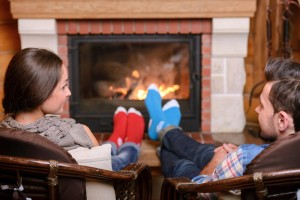 Want to know how your fireplace or stove sizes up to the one in your neighbor’s home? Today, we take a look at a few different options for fireplace style and fuel type. Whether you’re in the market for a new system or wondering how your fireplace sizes up, our chimney sweeps want to make sure you have the information you need.
Want to know how your fireplace or stove sizes up to the one in your neighbor’s home? Today, we take a look at a few different options for fireplace style and fuel type. Whether you’re in the market for a new system or wondering how your fireplace sizes up, our chimney sweeps want to make sure you have the information you need.
Wood-Burning Stoves and Fireplaces
The classic wood-burning fireplace is what many of us think of when we think of the traditional setup, but is this the right choice for everyone?
Pros
- A comforting, familiar presence in any home. The ambiance supplied by a wood fireplace or wood stove is, to many, unmatched in other fireplaces.
- Can add to the décor.
- Often increases the value of a home.
- Already built in to many homes, especially in our service area.
- No need to use up electricity or gas. You are in control of the fuel source, so long as you have wood on hand.
Cons
- Not the most efficient option. It’s a common misconception that a wood fireplace or stove is an efficient heating option. Most of the heat produced by burning wood is actually lost to the chimney.
- Costly. Adding a wood fireplace into a home can be expensive.
- Inconvenient. Building a fire can be difficult and requires skill.
- Fuel source must be acquired ahead of time. In addition, wood should be seasoned (left to dry) for 6 months or more.
- Messy. You must clean the ashes and worry about dangerous creosote build up in the chimney.
- Potentially unsafe. There is a potential fire hazard, and air quality concerns with smoke and gases.
Gas Fireplaces
A wide range of gas fireplace design is now available, and it’s a convenient option for many.
Pros
- Installation is convenient for many. Unless you are building a new home, adding a wood fireplace is not easy or convenient. It’s much easier to add a gas fireplace and vent.
- Efficient. Most modern gas fireplaces have efficiencies greater than 80%.
- Unique. In the past, gas fireplaces were seen as an unattractive option. But today, your gas fireplace can be designed to look just like a wood fireplace. There are so many designs available, that you are sure to find one that matches your home’s style.
Cons
- Cost of installation may be higher than expected. This is true if you will need to install a chimney or vent system.
- Potentially unsafe. Gas fireplaces do have a flame, which means there is a potential for fire or burns.
- Availability of natural gas. In some homes, this is an issue, and propane tanks may be necessary.
Electric Fireplaces
In some homes, an electric fireplace is the ideal. However, we see a lot of problems with this type of heater.
Pros
- Safety. Many people feel a lot safer with an electric fireplace heating the home.
- Cost of installation. This is perhaps the least expensive fireplace option you can invest in.
Cons
- Takes away from the decor. Truth be told, a gas fireplace does little to enhance the look and feel of a room.
- Inefficiency. The cost of electricity can be quite high, and we certainly wouldn’t recommend it for heating a room for very long.
- Comfort. Heat is easily lost with an electric fireplace. All in all, we wouldn’t recommend these to most homeowners looking for a permanent home solution.
2nd Generation Chimneys, Inc. offers fireplace installation and services in Minneapolis, MN. Contact our team today!
